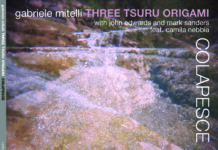Daniel Barbiero
 Astratto: Il tempo è un elemento strutturale nelle opere timbriche. Esso svolge un ruolo sintattico grazie alla sua capacità di integrare e separare eventi sonori. Spazi negativi, silenzi, sono elementi di tempo che stabiliscono i confini tra eventi e quindi creano relazioni interne all’opera e, contemporaneamente, tra l’opera e il suo ambiente esterno.
Astratto: Il tempo è un elemento strutturale nelle opere timbriche. Esso svolge un ruolo sintattico grazie alla sua capacità di integrare e separare eventi sonori. Spazi negativi, silenzi, sono elementi di tempo che stabiliscono i confini tra eventi e quindi creano relazioni interne all’opera e, contemporaneamente, tra l’opera e il suo ambiente esterno.è ragionavole concepire il tempo come una connessione più o meno continua
— Sergio Moravia, L’enigma dell’esistenza p. 210.
Time is the essential framework for all music, but for timbral music it has a central part to play in the plastic organization of the work. In contrast to its role within more conventional musics, within timbral music time is more of a structuring element, less of an empty container. If plastic organization consists in the relationships among formal elements within a work, time provides the terms in which the composition or performance can be realized as a structured object by putting in place the relationships intrinsic to the composition or performance.
Compositions organized by pitch or functional harmony, while necessarily realized in time, primarily follow the logic inherent in pitch or harmonic relationships that can be perceived independently of the length of time it takes them to unfold. By contrast, the organizational logic of timbral music is a function of the way that time creates plastic meaning within the work by bringing sound events into relation with each other. In other words, the relations between parts of a timbral composition or performance are defined by their positions in time; time here takes on a syntactic role in creating the internal structure of the work.
The syntactic function of time in timbral music is felt most directly through the qualities of integration and separation. (These qualities describe the perception that individual sound events do or do not make up a larger unit.) Whether or not we hear sound events as integrated or separated is tightly bound up with their perceived positions relative to each other in time. As James Tenney noted in Meta+Hodos, our perception of the integration or separation of sound events is sensitive to the perceived length of the temporal distances between them. Sounds grouped closely together in time seem to belong to the same event, whereas sounds separated by a substantial stretch of time seem to belong to separate events. (Temporal relationships take much, though not all, of the role of establishing continuity. Other sources of continuity might consist in similarities of color or density, but even here time as concretized in memory has a role to play in the overall perception of similarity.)
Negative space, or the absence of intended sounds, here has the function of providing boundaries within which sound events are perceived as continuous and across which they are perceived as discontinuous; negative space, in other words, just is the unfilled temporal distance between composed or performed sounds. Negative space thus plays a significant syntactic role in the perception of sound events’ belonging together or not.
Foregrounding the role of negative space in timbral work is a means of integrating or separating the constituent parts of the work relative to each other and thus of creating phrase structure, the continuous passage being the rough equivalent of the phrase in conventional music.
And yet significant passages of negative space not only create relationships internal to the work, but also reveal relationships between the work and its environment. By integrating sound events internal and external to the composition or performance, substantial silences place the work as one element within a larger structure encompassing elements outside the work. The archetypal composition to explore this dimension of silence was John Cage’s 4’33”. By demonstrating that significant pauses in intentional sound-making do not lead to an absence of sound, but rather constitute a leaving open to sound—the performance opened up onto a paradox through which it surpassed itself. That paradox—that silence as a significant compositional element in itself frees the listener to hear sounds extraneous to the composition—is made intelligible by virtue of the role of silence in creating structural relationships between sound events. The intent behind 4’33” may have been to foreground attentiveness to incidental sounds, but its implications go beyond the phenomenology of listening to encompass the role of silence as a means of integrating or separating the work and its surroundings.*
Paradoxically, an awareness of the sounds surrounding a work serves to frame and set off the work as an element in itself, and thus directs attention back to the sounds realized in the performance of the work. This direction of attention both away from and toward the work is the embodiment of the dialectic of negative space, which works through a kind of exchange of sounds within and outside of the work. Given a situation in which structurally significant silences allow sounds extrinsic to a performance to permeate the performance, these extrinsic sounds become—at least contingently—intrinsic. They become, in other words, constituent elements of the performance. From a structural point of view, they make up one part among other parts of a single whole to be listened to.
The syntactic role played by temporal relationships within a work thus is a complicated one, capable of integrating and separating elements at the local level as well as at the level of the whole.
=====
*Some of my recent work, such as Not One Nor, after 30 x 12(for C. Reider), and the Sound Rowseries, explores the syntactic function of negative space within timbral music.







